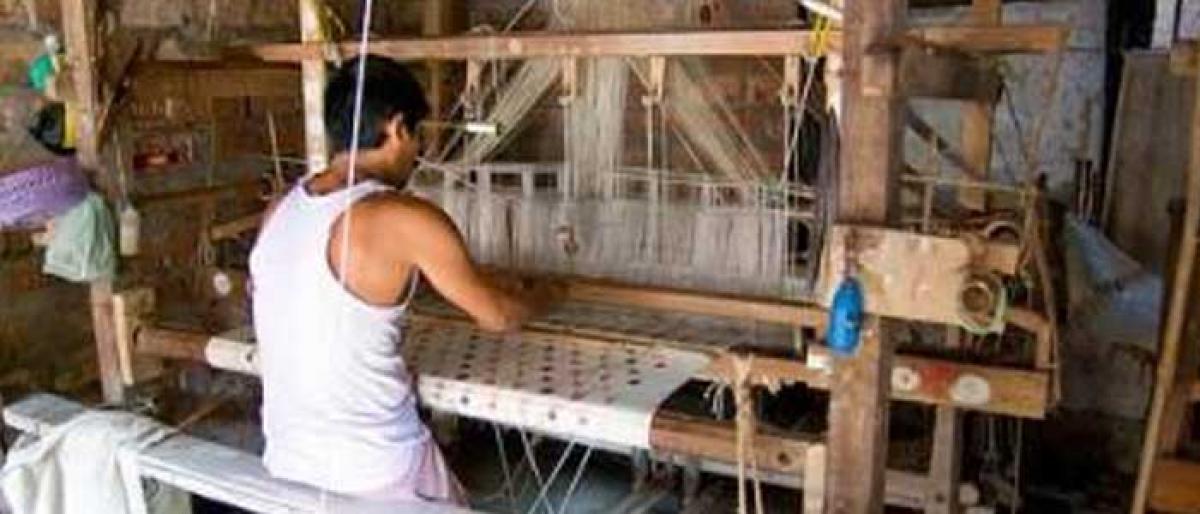Live
- 2024 on track to be hottest year on record
- PM Modi’s visit to Solapur: Women applaud ‘Double-Engine’ government’s initiatives
- Nagarkurnool MLA Dr. Kuchukulla Rajesh Reddy Campaigning in Maharashtra Elections
- Wife Kills Husband with Her Lover: Details of Veldanda Murder Case Revealed by SP Gaikwad
- Strict Action on Violations of Food Rights: Telangana Food Commission Chairman Goli Srinivas Reddy
- Smooth Conduct of Group-3 Exams with Strict Security Measures: Collector Badavath Santosh
- Delhi HC orders cancellation of LOC issued against Ashneer Grover, wife
- Shami’s absence a major blow for India in BGT, says Paul Adams
- Will organize protests at borders if attack on minority Hindus in Bangladesh not stopped: Bengal LoP
- Dutch Ambassador Marisa Gerard Meets Telangana CM A. Revanth Reddy in Delhi
Just In

Arun Jaitley’s fifth budget has dealt a huge blow to handloom sector with a huge reduction from Rs 604 crore in 2017-18 to a mere Rs 386.09 crore in 2018-19. It is already reeling under the twin effects of demonetisation and levy of GST. Never before in the last 100 years has the handloom sector seen such a low.
Arun Jaitley’s fifth budget has dealt a huge blow to handloom sector with a huge reduction from Rs 604 crore in 2017-18 to a mere Rs 386.09 crore in 2018-19. It is already reeling under the twin effects of demonetisation and levy of GST. Never before in the last 100 years has the handloom sector seen such a low.
Demonetisation severely affected handloom weavers, as handloom production is part of a huge informal economy. Cash crisis hit them badly, and the tight norms of cash withdrawals robbed them of any non-government, private money lender support as well. With losses and mounting debts, handloom weavers hoped that the government would announce relief and enable some direct cash transfers.
The government seems to have run out of ideas. It is not even doing any consultations. A welcome move has been the celebration of National Handloom Day on August 7th. This celebration, initiated and actively participated by Prime Minister Narender Modi has raised lot of hopes and expectations among handloom consumers, producers and economists.
Handloom sector budget is reduced drastically, across all schemes. With rising cost of production, unfair competition, and subsidies to rival sectors, handloom sector is being killed deliberately. Huge cuts in yarn supply scheme allocations is bound have its impact.
This impact would be double when one considers the rising costs of raw material, mostly yarn (silk, cotton, wool and other natural fibres), due to inflation, GST and fossil fuel prices.
Handloom weavers did not get any relief in the NDA rule. They have been hoping for higher allocations, especially after Narendra Modi, announced 7th August, every year, as National Handloom Day. With Make-In-India campaign, and the government leaders being followers of Madan Mohan Malaviya’s economics, they generally hoped that handloom sector would receive major thrust in government budgets. But the fourth budget is equally disappointing.
BJP manifesto is only talk
BJP Manifesto, and the election-eve speeches of their leaders, have promised an inclusive development – Sabka Saath Sabka Vikaas. Arun Jaitley’s budget has not included handloom weavers. Handloom sector which provides employment to more than 1 crore people gets a paltry Rs 710 crore. A ‘Make in India’ and ‘India Handlooms’ programme lie at the consumer end. Handloom weavers require basic support at production level. Their wages have to increase, incomes have to respond to living costs and families have to confidence in this livelihood.
BJP promised to strategically develop labour-intensive manufacturing. Per capita spending of the government on handloom sector, a labour intensive textile manufacturing sector spread all over India, does not exceed Rs 500.
But, it is ready to spend Rs 1,000 crore on Self-Employment and Talent Utilization (SETU). Government’s target of encouraging self-employment would have been reached with smaller investments in handloom sector. Thousands of handloom weavers are becoming poorer by the day, as their wages are not increasing.
Allocation of Rs 6,200 crore for youth, towards SANKALP and STRIVE schemes in 2017-18, was basically to improve employment and skills. Handloom weavers’ employment does not seem to have same priority in government’s plan of action.
Handloom weavers have been demanding for long for provision of access to low interest credit. Presently, to produce handloom products, they are borrowing money at exorbitant interest rates, ranging from normal to the bizarre, from 14 percent to 60 per cent.
Debt burden on individual handloom weavers has been for multiple reasons over which they do not have any control or say. Cost of living has increased in the last fifteen years steadily, and tremendously over the last few years, generously aided by inflation and under regulation of basic food commodity prices.
Cost of raw material, especially cotton and silk yarn have also gone up. Prices of yarn have been climbing continuously. Silk has been climbing rapidly in the last four years. With competition, from cheap and fake handloom products, wearing them down, handloom weavers had no way to increase their incomes to respond to raising costs of living and raw material prices.
Further, the most critical component of their production, working capital flows are drying up from ‘traditional sources’ and institutional mechanisms. NABARD the only comparatively cheap source of finances for handloom sector has drastically reduced its exposure. AS a result, handloom weavers are forced to find ‘expensive’ private sources of finances. In this scenario, loan waiver was a necessity and a requirement.
By: Dr D Narasimha Reddy

© 2024 Hyderabad Media House Limited/The Hans India. All rights reserved. Powered by hocalwire.com







